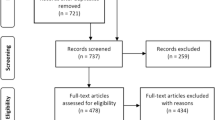Abstract
The Stereotypic behavior of children (N = 26) while in a playroom session with their parent was studied. The sample included children with a pervasive developmental disorder, an attention-deficit/hyperactivity disorder, a developmental expressive language disorder, or a developmental receptive language disorder and normally developing children. Stereotypic behaviors associated with distress, elation, and composure were compared on mean duration and form of the stereotypies and heart rate changes around the onset of the stereotypies. Results showed that stereotypies associated with different moods differed in all variables studied. Results confirm that a valid classification scheme for Stereotypic behaviors is needed as they indicate different functions of individual stereotypies.
Similar content being viewed by others
REFERENCES
American Psychiatric Association. (1987). Diagnostic and statistical manual of mental disorders (3rd ed., Rev.). Washington, DC: Author.
American Psychiatric Association, (1994). Diagnostic and statistical manual of mental disorders (4th ed.). Washington, DC: Author.
Bachara, G. H., & Phelan, W. J. (1980). Rhythmic movement in deaf children. Perceptual and Motor Skills, 50, 933–934.
Broom, D. M. (1991). Assessing welfare and suffering. Behavioral Processes, 25, 117–123.
Cohen, J. (1960). A coefficient of agreement for nominal scales. Educational and Psychological Measurement, 20, 37–46.
Cronin, G. M., Wiepkema, P. R., & Van Ree, J. M. (1986). Endorphins implicated in stereotypies of tethered sows. Experientia, 42, 198–199.
Dantzer, R. (1991). Stress, stereotypies and welfare. Behavioral Processes, 25, 95–102.
Dantzer, R., & Mormede, P. (1983). De-arousal properties of stereotyped behavior: Evidence from pituitary-adrenal correlates in pigs. Applied Animal Ethology, 233–244.
Grossman, P. (1992). Respiratory and cardiac rhythms as windows to central and autonomic biobehavioral regulation: Selection of window frames, keeping the panes clean and viewing the neural topography. Biological Psychology, 34, 131–161.
Guess, D., & Carr, E. (1991). Emergence and maintenance of stereotypy and self-injury. American Journal on Mental Retardation, 96, 299–319.
Hessing, M. J. C., Mette Hagelso, A., Schouten, W. G. P., Wiepkema, P. R., & van Beek, J. A. M. (1994). Individual behavioral and physiological strategies in pigs. Physiology & Behavior, 55, 39–46.
Hutt, C., Forrest, S. J., & Richer, J. (1975). Cardiac arrhythmia and behavior in autistic children. Acta Psychiatrica Scandinavica, 51, 361–372.
Jones, G. H., Mittleman, G., & Robbins, T. W. (1989). Attenuation of amphetamine stereotypy by mesostriatal dopamine depletion enhances plasma corticosterone: Implications for stereotypy as a coping response. Behavioral and Neural Biology, 51, 80–91.
Koegel, R. L., & Covert, A. (1972). The relationship of self-stimulation to learning in autistic children. Journal of Applied Behavior Analysis, 5, 381–387.
Koegel, R. L., Firestone, P. B., Kramme, K. W., & Dunlap, G. (1974). Increasing spontaneous play by suppressing self-stimulation in autistic children. Journal of Applied Behavior Analysis, 7, 521–528.
Lewis, M. H., Baumeister, A. A., & Mailman, R. B. (1987). A neurobiological alternative to the perceptual reinforcement hypothesis of stereotyped behavior: A commentary on self-stimulatory behavior and perceptual reinforcement. Journal of the Applied Behavior Analysis, 20, 253–258.
Lewis, M., Maclean, W. E., Bryson-Brockmann, W., Arendt, R., Beck, B., Fidler, P. S., & Baumeister, A. A. (1984). Time-series analysis of stereotyped movements: Relationship of body-rocking to cardiac activity. American Journal of Mental Deficiency, 89, 287–294.
Lovaas, O. I., Litrownik, A., & Mann, R. (1971). Response latencies to auditory stimuli in autistic children engaged in self-stimulatory behavior. Behavior Research and Therapy, 9, 39–49.
Mason, G. J. (1991). Stereotypies and suffering. Behavioral Processes, 25, 103–115.
Mason, G. J., & Turner, M. A. (1993). Mechanisms involved in the development and control of stereotypies. In P. P. G. Bateson, P. H. Klopfer, & N. K. Thompson (Eds.), Perspectives in Ethology, Volume 10: Behavior and evolution (pp. 53–85). New York: Plenum Press.
Noldus, L. P. J. J. (1991). The observer: a software system for collection and analysis of observational data. Behavior Research Methods, Instruments & Computers, 23, 415–429.
Rago, W. V., & Case, J. C. (1978). Stereotyped behavior in special education teachers. Exceptional Children, 44, 342–344.
Risley, T. (1968). The effects and side effects of punishing the autistic behaviors of a deviant child. Journal of Applied Behavior Analysis, 1, 21–34.
Schouten, W., Rushen, J., & De Passille, A. M. B. (1991). Stereotypic behavior and heart rate in pigs. Physiology & Behavior, 50, 617–624.
Schouten, W., & Wiepkema, P. R. (1991). Coping styles of tethered sows. Behavioral Processes, 25, 125–132.
Soussignan, R., & Koch, P. (1985). Rhythmical stereotypies (leg swinging) associated with reductions in heart-rate in normal school children. Biological Psychology, 21, 161–167.
Sroufe, L. A., Stuecher, H. U., & Stutzer, W. (1973). The functional significance of autistic behaviors for the psychotic child. Journal of Abnormal Child Psychology, 1, 225–240.
Treiber, F. A., Musante, L., Hartdagan, S., Davis, H., Levy, M., & Strong, W. B. (1989). Validation of a heart rate monitor with children in laboratory and field settings. Medicine and Science in Sports and Exercise, 21, 338–342.
Tröster, H. (1994). Prevalence and functions of stereotyped behaviors in nonhandicapped children in residential care. Journal of Abnormal Child Psychology, 22, 79–97.
Tröster, H., Brambring, M., & Beelmann, A. (1991). Prevalence and situational causes of stereotyped behaviors in blind infants and preschoolers. Journal of Abnormal Child Psychology, 19, 569–590.
Wiepkema, P. R., & Schouten, W. G. P. (1992). Stereotypies in sows during chronic stress. Psychotherapy and Psychosomatics, 57, 194–199.
Willemsen-Swinkels, S. H. N., Buitelaar, J. K., & Van Engeland, H. (1997). Children with a Pervasive Developmental Disorder, children with a Language Disorder and normally developing children in situations with high-and low-level involvement of the caregiver. Journal of Child Psychology and Psychiatry, 38, 327–336.
Wing, L., & Gould, J. (1979). Severe impairments of social interaction and associated abnormalities in children: Epidemiology and classification. Journal of Autism and Developmental Disorders, 9, 11–29.
Author information
Authors and Affiliations
Rights and permissions
About this article
Cite this article
Willemsen-Swinkels, S.H.N., Buitelaar, J.K., Dekker, M. et al. Subtyping Stereotypic Behavior in Children: The Association Between Stereotypic Behavior, Mood, and Heart Rate. J Autism Dev Disord 28, 547–557 (1998). https://doi.org/10.1023/A:1026008313284
Issue Date:
DOI: https://doi.org/10.1023/A:1026008313284




